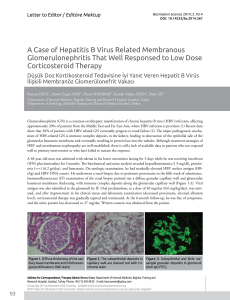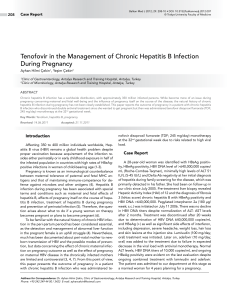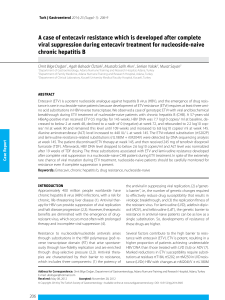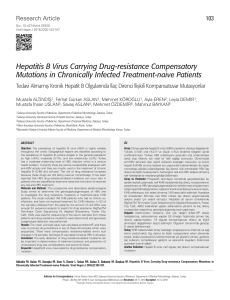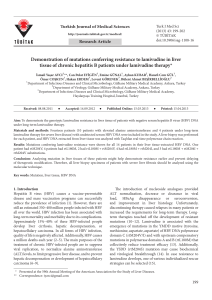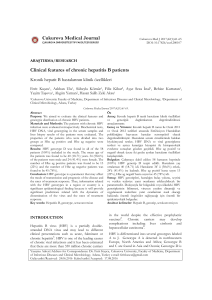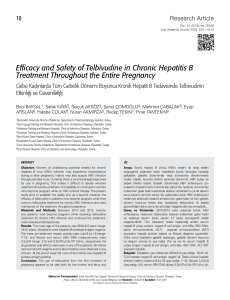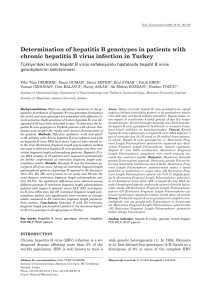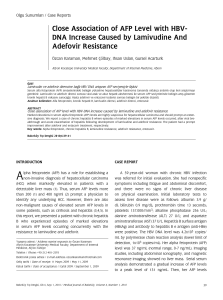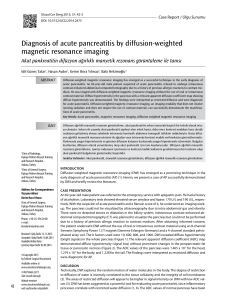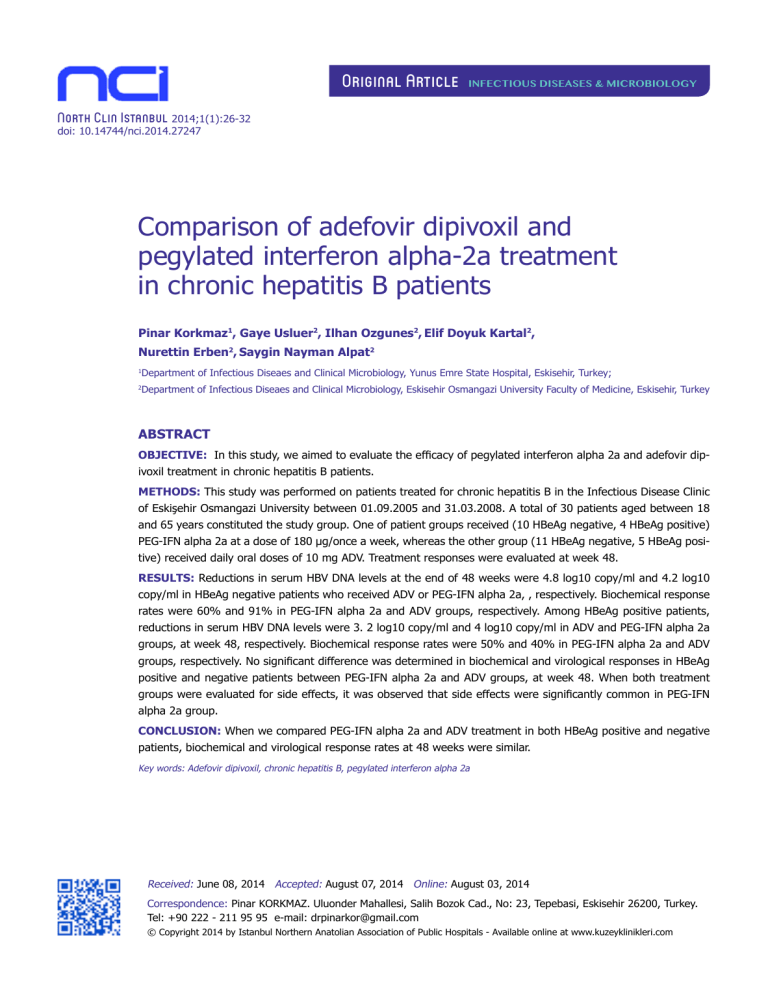
Orıgınal Article
INFECTIOUS DISEASES & MICROBIOLOGY
North Clin Istanbul 2014;1(1):26-32
doi: 10.14744/nci.2014.27247
Comparison of adefovir dipivoxil and
pegylated interferon alpha-2a treatment
in chronic hepatitis B patients
Pinar Korkmaz1, Gaye Usluer2, Ilhan Ozgunes2, Elif Doyuk Kartal2,
Nurettin Erben2, Saygin Nayman Alpat2
Department of Infectious Diseaes and Clinical Microbiology, Yunus Emre State Hospital, Eskisehir, Turkey;
1
Department of Infectious Diseaes and Clinical Microbiology, Eskisehir Osmangazi University Faculty of Medicine, Eskisehir, Turkey
2
ABSTRACT
OBJECTIVE: In this study, we aimed to evaluate the efficacy of pegylated interferon alpha 2a and adefovir dipivoxil treatment in chronic hepatitis B patients.
METHODS: This study was performed on patients treated for chronic hepatitis B in the Infectious Disease Clinic
of Eskişehir Osmangazi University between 01.09.2005 and 31.03.2008. A total of 30 patients aged between 18
and 65 years constituted the study group. One of patient groups received (10 HBeAg negative, 4 HBeAg positive)
PEG-IFN alpha 2a at a dose of 180 μg/once a week, whereas the other group (11 HBeAg negative, 5 HBeAg positive) received daily oral doses of 10 mg ADV. Treatment responses were evaluated at week 48.
RESULTS: Reductions in serum HBV DNA levels at the end of 48 weeks were 4.8 log10 copy/ml and 4.2 log10
copy/ml in HBeAg negative patients who received ADV or PEG-IFN alpha 2a, , respectively. Biochemical response
rates were 60% and 91% in PEG-IFN alpha 2a and ADV groups, respectively. Among HBeAg positive patients,
reductions in serum HBV DNA levels were 3. 2 log10 copy/ml and 4 log10 copy/ml in ADV and PEG-IFN alpha 2a
groups, at week 48, respectively. Biochemical response rates were 50% and 40% in PEG-IFN alpha 2a and ADV
groups, respectively. No significant difference was determined in biochemical and virological responses in HBeAg
positive and negative patients between PEG-IFN alpha 2a and ADV groups, at week 48. When both treatment
groups were evaluated for side effects, it was observed that side effects were significantly common in PEG-IFN
alpha 2a group.
CONCLUSION: When we compared PEG-IFN alpha 2a and ADV treatment in both HBeAg positive and negative
patients, biochemical and virological response rates at 48 weeks were similar.
Key words: Adefovir dipivoxil, chronic hepatitis B, pegylated interferon alpha 2a
Received: June 08, 2014 Accepted: August 07, 2014 Online: August 03, 2014
Correspondence: Pinar KORKMAZ. Uluonder Mahallesi, Salih Bozok Cad., No: 23, Tepebasi, Eskisehir 26200, Turkey.
Tel: +90 222 - 211 95 95 e-mail: [email protected]
© Copyright 2014 by Istanbul Northern Anatolian Association of Public Hospitals - Available online at www.kuzeyklinikleri.com
Korkmaz et al., Adefovir dipivoxil and pegylated interferon alpha-2a treatment in hepatitis B patients
N
early 350 million people in the world have
been estimated to contract chronic hepatitis
B (CHB). Chronic hepatitis B patients have a higher risk of developing cirrhosis, hepatic failure, and
hepatocellular carcinoma (HCC) [1]. Every year
nearly one million people die from end-stage hepatic failure, and eventually 5-10% of them require
liver transplantation [2]. Effective treatment modalities are needed to prevent progression of CHB
to HCC, and death [3]. Therapeutic targets include
suppression of the HBV replication, histopathological recovery of the liver, eradication of HBV, prevention of cirrhosis, and HCC, and prolongation of
life span [4].
Currently, drugs used in the treatment of CHB
are conventional interferon-alpha, pegylated interferon-alpha (PEG-IFN α-2a and α-2b), lamivudine, telbivudine, emtricitabine, entecavir, adefovir
dipivoxil (ADV), and tenofovir [2].
Interferons (IFNs) have antiviral, antiproliferative, and immunomodulator effects. Because of
short half-lives of classical interferons, fluctuations
in blood levels of these drugs can be seen which
decrease antiviral efficacy of them. Side effects are
more frequently seen when conventional interferons
reach to their peak serum levels. To preclude these
disadvantages polyethylene glycol molecules were
added to interferons, and pegylated interferons
have been obtained. Thus, half-lives of interferons
are prolonged, and once weekly doses have ensured
sustained antiviral response [5, 6].
Non-interferon treatment alternatives of CHB
include nucleotide analogues. Adefovir, is a prodrug of ADV. Adefovir is a acyclic nucleotide analogue of adenosine diphosphate [7]. Adefovir is
phosporylated to its active metabolite adenosine
diphosphate by cellular kinases. Following entry of
adefovir diphosphate into viral DNA, it depletes
DNA with resultant inhibition of HBV DNA
polymerase. It is a weak inhibitor of human DNA
polymerases [8].
This study was planned to compare therapeutic
effectiveness of 48 weeks of ADV, and PEG-IFN
α-2a therapies in CHB patients followed up in clinics of infectious diseases of our university hospital.
27
MATERIALS AND METHODS
A total of 30 patients (HBeAg negative, n=21, and
HbeAg positive, n=9) who were followed up in the
Department of Infectious Diseases of our University hospital between 09.01. 2005, and 03.31. 2008
were included in the study. Approval of the Ethics
Committee of our University was obtained. All patients were informed about the study, and they were
enrolled in the study after receival of their written
informed consent.
Inclusion criteria:
• Male, and female patients aged between 18-65
years whose HbsAg positive status lasted for
more than 6 months,
• HBeAg-negative CHB patients with HBV
DNA levels over 104 copies/ml, and elevated
(1.3-10 ULN) or normal (0-40 IU/L) alanine
aminotransferase (ALT) levels
• HBeAg-positive CHB patients with HBV
DNA values over 105 copies/ml together with
elevated or normal ALT levels,
• Previously untreated patients or those with posttreatment recurrences (cases who received last
dose of treatment 6 months ago)
Exclusion criteria:
• Patients who received CHB treatment within
the previous 6 months, those with hepatitis A,
C or D or HIV co-infection, pregnancy, autoimmune disease, malignancy, decompensated
liver disease, metabolic liver disease, severe
psychiatric disease, serious cardiac, and pulmonary diseases, decreased Hb values (<12 g/
dl in female, and <13 g/dl in male patients),
lower neutrophil counts (<1500/mm3), and
increased (>1.5 mg/dl) creatinine levels.
Patients who met inclusion criteria underwent
liver biopsy, and patients with biopsy-proven chronic liver disease were divided into 2 groups.One of
these groups received weekly subcutaneous doses of
180 µg PEG-IFN α-2a, while the other group was
treated with daily oral doses of 10 mg ADV. Evaluation period was determined as 48 weeks. Patients
who received pegylated interferon were monitored at
the second weeks of treatment after at the end of the
28
North Clin Istanbul – NCI
first month of the treatment, and then at 4-weekly intervals. In the ADV group, the first follow-up
visit was performed at the end of the first month,
after at the third months of treatment and then at
3-monthly intervals. Serum HBV DNA levels were
measured using Corbett Real Time PCR method
(viral load detection range of the device: 102-1011).
Evaluation of the treatment modalities: Decrease in
serum HBV DNA levels down to undetectable levels at the end of 48. weeks as measured with PCR
method was evaluated as virological response. However, regression of ALT levels down to normal limits
was considered as biochemical response. In HBeAgpositive patients, clearance of HBeAg, and anti-Hbe
positivity were evaluated as HBeAg seroconversion.
For statistical analysis, SPSS 13.0, and Sigmastat package programs were used.In statistical
analysis, normality tests, frequency tables, T-test,
Mann Whitney U-test, two way repeated measures
ANOVA, and chi-square tests were used. P<0.05
was considered as the level of statistical significance.
RESULTS
Study population consisted of 11 female (36.6%),
and 19 male (63.4%) patients. Baseline characteristics of HBeAg-positive, and negative patients are
seen in Table 1.
Table 1.
Any difference was not detected between groups
of patients who received PEG-IFN α-2a or ADV as
for reduction in HBV DNA values at the end of 12.,
24., and 48. weeks (p>0.05) (Table 2). A significant
difference was not detected among HBeAg –positive, and HbeAg-negative patients in the PEG-IFN
α-2a and ADV groups with respect to biochemical,
and virological response rates (p>0.05) (Table 3).
HBeAg negativity was achieved in one patient in
both PEG-IFN α-2a, and ADV groups.
During the treatment process of the patients who
received PEG-IFN α-2a, side effects such as fever,
headache, dizziness, lassitude, myalgia, nausea, abdominal pain, dry mouth, nosebleed, pruritus, dry
skin, and itching, reaction at the injection site, hair
loss, weight loss, loss of appetite, irritability, and insomnia were seen. However, neutropenia, thrombocytopenia, and thyroid dysfunction were the most
frequently detected laboratory abnormalities. Dose
modifications were made in 42.8% of the patients
who received PEG-IFN, and treatment of none of
these patients was prematurely terminated because
of development of side effects. Emergence of neutropenia, and thrombocytopenia required dose reduction in 28.5, and 14.3% of the patients who received PEG-IFN, respectively. (Table 4). However
in the ADV treatment group, most frequently seen
side effects were headache (n=3; 18.7%), abdominal
Baseline characteristics of the patients
Characteristics Age (years)
Gender
Female
Male
ALT*
HBV DNA
(log 10 copies/ml)*
Fibrosis*
HBeAg (-)
HBeAg (+)
‡
PEG-IFN
ADV p
alpha 2a
†
33.2±10.3
2 (20%)
8 (80%)
126.70±177.24
5.36±0.72
1.50±0.85
43.2±9.3
<0.05
5 (45.5%)
>0.05
6 (54.5%)
89.18±77.73
>0.05
6.39±1.67
>0.05
2±1.09
>0.05
*Mean±SD; †PEG-IFN alpha 2a, pegylated interferon-alpha 2a; ‡ADV, adefovir dipivoxil.
PEG-IFN
alpha 2a
ADV
p
28.7±9.9
30.6±5.9
>0.05
–
4 (100%)
254.75±128.26
7.3±1.2
4 (80%)
1 (20%)
148.8±171.30
6.9±1.2
<0.05
2.25±0.95
1.80±1.3
>0.05
>0.05
>0.05
Korkmaz et al., Adefovir dipivoxil and pegylated interferon alpha-2a treatment in hepatitis B patients
29
Table 2. Mean HBV DNA values at certain time points of PEG-IFN alpha 2a, and ADV treatment in patients with
HBeAg negative, and positive patients
HBV DNA (10 log copies/ml) *
Onset of treatment 12. weeks
24. weeks
48. weeks
HBeAg (–)
HBeAg (+)
‡
PEG-IFN
ADV p
alpha-2a
†
5.3±0.7
1.1±1.2
1.1±1.1
1.1±1.8
6.3±1.6
2.2±2.4
1.6±2.2
1.5±1.8
>0.05
>0.05
>0.05
>0.05
PEG-IFN
alpha-2a
†
7.39±1.21
3.3±3.0
3.5±2.2
3.3±2.7
ADV
p
6.9±1.2
5.1±2.7
4.2±3.9
3.7±3.4
>0.05
>0.05
>0.05
>0.05
†
*Mean±SD; †PEG-IFN alpha 2a, pegylated interferon-alpha 2a; ‡ADV, adefovir dipivoxil.
Table 3. Biochemical, and virological response rates (n, %)
Characteristics obtained with PEG-IFN α-2a, and ADV treatments
HBeAg (–)
HBeAg (+)
‡
PEG-IFN
ADV p
alpha-2a
†
Biochemical responses, n
Virological responses, n 6 (60%)
9 (90%)
10 (91%)
9 (82%)
>0.05
>0.05
PEG-IFN
alpha-2a
2 (50%)
1 (25%)
ADV
p
2 (40%)
2 (40%)
>0.05
>0.05
*PEG-IFN alpha 2a, pegylated interferon-alpha 2a; †ADV, adefovir dipivoxil.
pain (n=2; 12.5%), and dyspepsia (n=2; 12.5%). In
none of the patients in the ADV group increase in
serum creatinine values, and alterations in serum
phosphorus levels were seen.
DISCUSSION
PEG-IFN α-2a, and ADV are among recommended treatment modalities for CHB both in national,
and international consensus reports [2, 4, 9, 10].
In the evaluation of treatment response in CHB,
normalization of serum ALT levels, decrease in serum HBV DNA levels, loss of HbeAg in HbeAg
positive patients, and improvement in histopathological markers of CHB are taken into consideration. Endpoints for CHB are normalization of
ALT, suppression of HBV DNA to undetectable
levels, loss or seroconversion of HBeAg in HBeAg
positive patients, and improvement in histopathological markers of CHB [11, 12].
In the treatment, decrease in HBV DNA levels
is important as for the suppression of viral replication. In HBeAg negative patients, Marcellin et al.
detected a decrease of 4.1 log copies/ml in the level
of HBV DNA, at the end of the treatment with
PEG-IFN α-2a, while Hadziyannis et al. revealed
a decrease of 3.91 log copies/ml in the level of HBV
DNA following 48 weeks of treatment with ADV.
[13, 14]. In our study, decreases in the mean HBV
DNA values were detected at the end of 48 weeks in
the group of patients who received PEG-IFN α-2a
or ADV (at levels of 4.2, and 4.8 log copies/ml , respectively). A statistically significant difference was
not found between both groups as for decreases in
30
North Clin Istanbul – NCI
Table 4. Most frequently seen side effects during pegylated interferon alpha 2 a treatment in HBeAg positive, and
negative patients
Side effect n
%
Fever
13
92.9
Weight loss
13
92.9
Headache
10
71.4
Hair loss 9
64.3
Lassitude
12
85.7
Muscle pain
12
85.7
Abdominal pain
4
28.6
Dry mouth
6
42.9
HBV DNA values at the end of 48 weeks (p>0.05).
Cooksley et al. and also Caruntu et al. detected
decreases in post-treatment HBV DNA levels in
HBeAg positive patients who received PEG-IFN
α-2a (decreases of 3.5, and 3 log copies/ml, respectively [15, 16]. Marcellin et al. detected a decrease
in HBV DNA levels at a rate of 3.5 log copies/ml,
and Zeng et al. disclosed a drop of 4.2 log copies/ml
in HBeAg positive patients who received ADV [17,
18]. In our patients who received PEG-IFN α-2a,
HBV DNA levels decreased down to 4 log copies/
ml, while in the ADV group a decrease in HBV
DNA levels was at a rate of 3.2 log copies/ml at the
end of 48 weeks. A significant difference couldn’t be
found between both groups as for decrease in HBV
DNA values at the end of 48 weeks (p>0.05).
Marcellin et al. detected end-treatment virological response (HBV DNA <400 copies/ml) rates
in HBeAg- negative patients who received PEGIFN α-2a (63%), PEG-IFN –LAM combination
(87%) or LAM (73%), as indicated in parentheses
[13]. Hadziyannis et al. reported median virological
response rate of 51% in HBeAg negative patients
under ADV treatment at the end of 48 weeks [14].
Virological response rates in patients who received
PEG-IFN α-2a or ADV were 90, and 82% at the
end of 48 weeks, respectively. A significant difference could not be found as for virological response
Side effect n
%
Dry skin. itching
Nosebleed
Injection site reaction Loss of appetite
Thyroid dysfunction Neutropenia
Thrombocytopenia Change in dosage, because of
Leukopenia
Thrombocytopenia
10
9
3
4
3
13
10
6
4
2
71.4
64.3
21.4
28.6
21.4
93
71.4
42.8
28.5
14.3
rates as assessed at the end of 48 weeks (p>0.05).
Lau et al. had detected end-treatment virological response rates (HBV DNA <400 copies/ml) in
HBeAg positive patients who received PEG-IFN
α-2a (25%), pegylated interferon alpha-LAM combination (69%), and LAM (40%) as indicated in parentheses [3]. Cooksley et al. noted end-treatment virological response rate in the PEG-IFN α-2a group
as 39 percent. While, Marcellin et al. revealed a 21%
virological response rate in HBeAg positive patients
who received ADV [15, 17]. In a study performed in
our country, end-treatment virological response rate
(HBV DNA <400 copies/ml) was detected as 33.3%
in HBeAg positive patients who received PEG-IFN
α-2a [19]. Virological response rates at the end of 48
weeks in our patients who received PEG-IFN α-2a
or ADV were found to be 25, and 40%, respectively.
A significant difference was not noted between both
treatment groups as for virological response rates at
the end of 48 weeks (p>0.05).
Another parametre indicative of treatment response, at the end of the treatment is normalization
of ALT levels. Different ALT normalization rates
were detected in HbeAg positive patients who received PEG-IFN α-2a (Lau et al., 41%) or ADV
(Marcellin et al., 48%) [3, 17]. In our HBeAg positive patients end-treatment ALT normalization
rates were 40% in the ADV, and 50% in the PEG-
Korkmaz et al., Adefovir dipivoxil and pegylated interferon alpha-2a treatment in hepatitis B patients
IFN α-2a groups. A significant intergroup difference could not be found as for mean ALT normalization rates at the end of 48 weeks (p>0.05).
Post-treatment ALT normalization rates were
found to be 59%, and 77% in HBeAg negative patients treated with PEG-IFN α-2a (Marcellin et al.)
or ADV (Hadziyannis et al.), respectively [13,14].
In a study performed in our country by Karabay
et al., post-treatment biochemical response rate in
HBeAg negative patients receiving PEG-IFN α-2a
was detected to be 37.1 percent [20]. ALT normalization rates in our HBeAg negative patients receiving PEG-IFN α-2a or ADV were 60, and 91%,
respectively. At the end of 48 weeks, both groups
did not differ as for biochemical response rates
(p>0.05).
Dogan et al. couldn’t detect HBeAg seroconversion at the end of 48 weeks in HBeAg positive
patients who received PEG-IFN α-2a [19]. In our
study, HBeAg negativity was achieved in one patient in both HBeAg treatment groups, without any
significant intergroup difference (p>0.05). HBeAg
seroconversion was not observed in both groups.
However because of scarcity of our patient population, larger scale studies should be performed for
the evaluation of this issue.
Most frequently seen side effects in our PEGIFN α-2a group were fever, myalgia, lassitude,
weight loss, skin itching, and dryness, nosebleed,
headache, hair loss, and dry mouth, However in our
ADV group mostly seen side effects were abdominal pain, headache, and dyspepsia. Our results related to side effects were in accordance with those of
the other studies [13, 14, 15, 21, 22, 23, 24, 25]. Remarkably, greater number of side effects were seen
in the PEG-IFN α-2a group relative to the ADV
group.
In 42.8% of our patients who received PEGIFN α-2a, treatment dose was changed. Most frequent causes of dose alterations were neutropenia,
and thrombocytopenia. These results were in accordance with those of the other studies [5, 13]. In
the PEG-IFN α-2a group dose alterations were required because of development of side effects, however in our ADV group dose modifications were not
31
necessitated. In both groups, any condition which
required discontinuation of treatment because of
side effects was not encountered.
In conclusion, 48 weeks of PEG-IFN α-2a,
and ADV treatments in both HBeAg positive, and
negative patients are not superior to each other with
respect to biochemical, and virological response
rates. When these medications were evaluated as
for side effects developing during treatments, PEGIFN α-2a therapy adversely effected quality of life
of the patients more frequently. Evaluation of sustained viral response is important in the selection of
treatment modality. Lack of any parametres which
allow us to evaluate sustained viral, and histological response suggests the need for long-term studies
which would evaluate therapeutic efficacy.
Conflict of Interest: No conflict of interest was declared by
the authors.
Financial Disclosure: The authors declared that this study
has received no financial support.
REFERENCES
1. Abbas Z, Siddiqui AR. Management of hepatitis B in developing countries. World J Hepatol 2011;3:292-9. CrossRef
2. European Association For The Study Of The Liver. EASL clinical practice guidelines: Management of chronic hepatitis B virus
infection. J Hepatol 2012;57:167-85.
3. Lau GK, Piratvisuth T, Luo KX, Marcellin P, Thongsawat S,
Cooksley G, et al. Peginterferon Alfa-2a, lamivudine, and the
combination for HBeAg-positive chronic hepatitis B. N Engl J
Med 2005;352:2682-95. CrossRef
4. Lok AS, McMahon BJ. Chronic hepatitis B: update 2009. Hepatology 2009;50:661-2. CrossRef
5. Keating GM. Peginterferon-alpha-2a (40 kD): A review of its
use in chronic hepatitis B. Drugs 2009;69:2633-60. CrossRef
6. Harris JM, Martin NE, Modi M. Pegylation: a novel process for
modifying pharmacokinetics. Clin Pharmacokinet 2001;40:53951. CrossRef
7. Kumar A, Dwivedi M, Misra SP, Narang S, Tiwari BK, Pandey
R. Clinical profile, genotype and management updates of hepatitis B virus. Indian J Virol 2011;22:1-10. CrossRef
8. Dando T, Plosker G. Adefovir dipivoxil: a review of its use in
chronic hepatitis B. Drugs 2003;63:2215-34. CrossRef
9. Keeffe EB, Dieterich DT, Han SH, Jacobson IM, Martin P,
Schiff ER, et al. A treatment algorithm for the management of
chronic hepatitis B virus infection in the United States: 2008 update. Clin Gastroenterol Hepatol 2008;6:1315-41; quiz 1286.
32
10. Hui AY, Chan HL, Cheung AY, Cooksley G, Sung JJ. Systematic
review: treatment of chronic hepatitis B virus infection by pegylated interferon. Aliment Pharmacol Ther 2005;22:519-28.
11. Dienstag JL. Hepatitis B virus infection. N Engl J Med
2008;359:1486-500. CrossRef
12. Hadziyannis SJ. New developments in the treatment of chronic
hepatitis B. Expert Opin Biol Ther 2006;6:913-21. CrossRef
13. Marcellin P, Lau GK, Bonino F, Farci P, Hadziyannis S, Jin R, et
al. Peginterferon alfa-2a alone, lamivudine alone, and the two in
combination in patients with HBeAg-negative chronic hepatitis
B. N Engl J Med 2004;351:1206-17. CrossRef
14. Hadziyannis SJ, Tassopoulos NC, Heathcote EJ, Chang TT,
Kitis G, Rizzetto M, et al. Adefovir dipivoxil for the treatment of
hepatitis B e antigen-negative chronic hepatitis B. N Engl J Med
2003;348:800-7. CrossRef
15. Cooksley WG, Piratvisuth T, Lee SD, Mahachai V, Chao YC,
Tanwandee T, et al. Peginterferon alpha-2a (40 kDa): an advance
in the treatment of hepatitis B e antigen-positive chronic hepatitis B. J Viral Hepat 2003;10:298-305. CrossRef
16. Caruntu FA, Streinu-Cercel A, Gheorghe LS, Grigorescu M,
Sporea I, Stanciu C, et al. Efficacy and safety of peginterferon alpha-2a (40KD) in HBeAg-positive chronic hepatitis B patients.
J Gastrointestin Liver Dis 2009;18:425-31.
17. Marcellin P, Chang TT, Lim SG, Tong MJ, Sievert W, Shiffman
ML, et al. Adefovir dipivoxil for the treatment of hepatitis B e antigen-positive chronic hepatitis B. N Engl J Med 2003;348:80816. CrossRef
18. Zeng M, Mao Y, Yao G, Wang H, Hou J, Wang Y, et al. A
double-blind randomized trial of adefovir dipivoxil in Chinese
North Clin Istanbul – NCI
subjects with HBeAg-positive chronic hepatitis B. Hepatology
2006;44:108-16. CrossRef
19. Dogan UB, Golge N, Akin MS. The comparison of the efficacy
of pegylated interferon α-2a and α-2b in chronic hepatitis B patients. Eur J Gastroenterol Hepatol 2013;25:1312-6. CrossRef
20.Karabay O, Tuna N, Esen S; PEG-HBV Study Group. Comparative efficacy of pegylated interferons α-2a and 2b in the
treatment of HBeAg-negative chronic hepatitis B infection. Eur
J Gastroenterol Hepatol 2012;24:1296-301.
21. Tözün N, Sezgın O, Gülşen M, Kacar S, Yenıce N, Yilmaz Ş, et
al. Safety of peginterferon alfa-2a (40KD) treatment in patients
with chronic hepatitis B infection: an observational, multicenter,
open label, non-interventional study in Turkish patients. Turk J
Gastroenterol 2012;23:552-9.
22. Kartal ED, Alpat SN, Ozgunes I, Usluer G. Adverse effects of
high-dose interferon-alpha-2a treatment for chronic hepatitis B.
Adv Ther 2007;24:963-71. CrossRef
23. Brunetto MR, Oliveri F, Coco B, Leandro G, Colombatto P, Gorin JM, et al. Outcome of anti-HBe positive chronic hepatitis B
in alpha-interferon treated and untreated patients: a long term
cohort study. J Hepatol 2002;36:263-70. CrossRef
24. Piccolo P, Lenci I, Demelia L, Bandiera F, Piras MR, Antonucci
G, et al. A randomized controlled trial of pegylated interferonalpha2a plus adefovir dipivoxil for hepatitis B e antigen-negative
chronic hepatitis B. Antivir Ther 2009;14:1165-74. CrossRef
25. Sun J, Hou JL, Xie Q, Li XH, Zhang JM, Wang YM, et al. Randomised clinical trial: efficacy of peginterferon alfa-2a in HBeAg
positive chronic hepatitis B patients with lamivudine resistance.
Aliment Pharmacol Ther 2011;34:424-31. CrossRef

